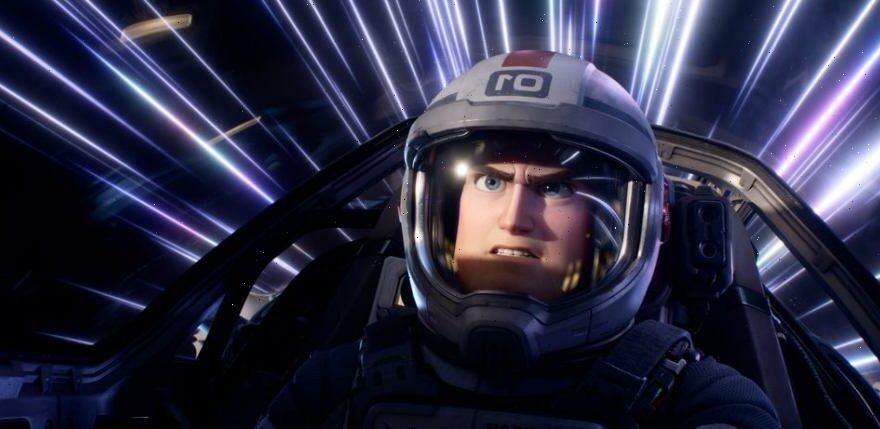“Lightyear,” the 26th Pixar film, has a premise that’s explained by the film’s opening title. It seems that in 1995, Andy, the young hero of “Toy Story,” was given a Buzz Lightyear action figure as a present. That was because he’d seen a Buzz Lightyear movie and loved it. “Lightyear” is that movie.
There are plenty of ways the Pixar wizards could have spun that premise. One imagines a Buzz Lightyear origin story in which he’s a brash young upstart going through flight training. And since Buzz, in his curvy plastic spacesuit with the chartreuse trim and the bubble helmet, is the most futuristic of all the “Toy Story” playthings, one could envision that film unfolding within the most deliriously Pixarian of sci-fi kiddie landscapes.
But “Lightyear,” in its eminently conventional and likable way, is a far less audacious movie than that. As it opens, Buzz is already more or less the Buzz Lightyear we know — an absurdly overconfident test pilot who’s a gifted flier but also a delectable egomaniac, too cocksure for his own good, given to stunts he thinks he can pull off just because…he’s Buzz. He and his crew, who are bopping around the galaxy exploring new worlds in the mode of the “Star Trek” team, have landed on a planet populated by thickly aggressive vines and the occasional rust-spotted robot. When they’re forced to make a quick getaway, piloting the spaceship (which Buzz calls “the turnip,” since it’s shaped like one) out of a steep valley, Buzz miscalculates, damaging the ship by scraping it against a rock face and stranding them all on the barren planet.
For what is surely not the first time, Buzz’s I-can-do-anything myopic bravado has failed. He thought what was happening was all about him. “Lightyear” will be the movie in which he learns to think and care about others, but even so, it plays less like an origin story than like the middle episode of an ongoing Buzz Lightyear adventure franchise.
The entire movie is about how Buzz, coming together with a trusty team of fellow space explorers, fights to get off that planet. First he tries to pilot his own rocket ship to hyper-speed — and as he keeps trying, and failing, to accomplish that, he returns from each experimental mission just a few minutes older, but several years have passed on the planet. This means that we watch the developing life of his friend and colleague, Capt. Hawthorne (Uzo Aduba), as she gets married (to a woman, which the film admirably makes no big deal about), has a child, and finally passes on. Her grandchild, Izzy (Keke Palmer), who’s her spitting image, joins Buzz’s crew, along with Sox (voiced by Peter Sohn), a hilariously matter-of-fact robot feline who looks like he was bought at a souvenir shop, plus Darby Steel (Dale Soules), a crusty felon, and Mo Morrison (Taika Waititi), a walking nerve case.
Can they destroy the massive robot alien spaceship that’s hovering in the sky — a mysterious craft presided over by a horned megabot, the Emperor Zurg (James Brolin), who has glowing red devil eyes? The identity of this dastardly droid turns out to be a lot closer to home than you’d expect. And “Lightyear” is full of elegantly fun chases and escapes and droll bits of gizmo business, like IVAN the auto-pilot Buzz despises, plus a witty gag about the evolution of the sandwich. Taken on its own eager-to-please terms, the movie is a winning diversion. But given that it’s a spinoff of the “Toy Story” series, which is the greatest and most sustained achievement in contemporary animation, it should be noted that this is one of those Pixar movies that feels like it has 50 percent Disney DNA.
A confession: The first time I saw ”Toy Story,” not knowing who the voice actors were, I was sure that Buzz, with his handsome thrusting chin and delirious assurance, had the look and the voice of George Clooney; I was shocked when I learned that he was voiced by Tim Allen. Through all three sequels, Allen has done a brilliant job of portraying Buzz with that inimitable fusion of heroism and fatuous narcissism, though I still think of the character as Clooneyesque. In “Lightyear,” however, he’s voiced by Chris Evans, who does a creditable job of recreating Buzz’s pilot-as-game-show-host-of-his-own-legend persona, though a bit of that Allen snap gets lost. The character seems less funny, a notch more ordinary.
Of course, part of that may be that in the “Toy Story” films, he is a toy — that’s part of the joke, one that Buzz is never quite in on. He thinks he’s a real Space Ranger! So when you actually turn Buzz Lightyear into a Space Ranger, you enlarge him and diminish him at the same time. You tone down his buzz. Throughout the movie, Buzz keeps trying to get home; he wants to resume his life of space exploration. He doesn’t realize that with his friends around him, he already is home. That’s a touching, if standard, message, but I couldn’t help but agree with Buzz — that as solid an entertainment as “Lightyear” is, it feels like he belongs in a more special movie. It makes you wonder: Is “Woody’s Wild West” going to be next? Because that sounds like a way, through sheer spin-off opportunism, of taking the toy, and maybe the joy, out of “Toy Story.”
Source: Read Full Article
